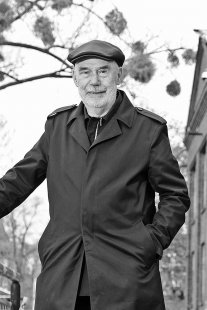
To the death of Peter Kulka
On Monday, February 5, German architect Peter Kulka passed away at the age of 86. He always approached his profession with thoroughness and could not understand when others did not share his passion for architectural quality. As a seven-year-old, he experienced the Allied bombing of Dresden and the total destruction of the city. He learned to live among the ruins. At twelve, he contemplated how to create something new from the debris. Reconstruction of the past was never an option for him. He always wanted to push architecture and society forward. Before studying architecture, he trained as a bricklayer in 1954. He then went on to study civil engineering in Görlitz, then in Gotha, and finally completed his architecture studies in 1964 at the art school in East Berlin's Weißensee, which was led by Bauhaus graduate Selman Selmanagić. Kulka gained his first work experience at the Academy of Building under Hermann Henselmann. After a year of practice, he dramatically escaped to West Berlin, where he worked at the office of Hans Scharoun from 1965 to 1968. In 1970, he teamed up with colleagues Herzog, Köpk, Siepmann, and Töpper and opened an office in Bielefeld, Germany, designing for the local university. In 1980, he settled in Cologne and, together with Hans Schilling, designed buildings for the local archdiocese. From 1986 to 1992, he served as a professor at the RWTH Aachen University of Technology. The reunification of Germany represented a starting signal for him for a new phase of life. He left the university and opened a second office in his native Dresden. The initial impetus was winning a competition for a new assembly hall for the Saxon State Parliament, which he managed to realize from 1991 to 1997. It was one of the first major public projects in the territory of the former GDR after reunification, when architects faced unprecedented opportunities. Kulka had the advantage of Western experience that he fully utilized in the East German environment. As early as 1995, he promoted that "our cities and buildings should be prepared for later reconstructions, environmentally friendly, and recyclable". Until the very end, he worked on the extension project of the Saxon State Parliament, which is set to start construction next year, and his adopted daughter Katrin Leers-Kulka will oversee the successful realization.
More information >
When I moved back to Europe after the fall of the Twin Towers, to study architecture at the Dresden University of Technology thanks to a scholarship from a Bavarian car manufacturer, the contemporary architecture expert Karel 'Kódl' Doležel recommended that I familiarize myself with the work of some Kulka in Dresden as soon as possible. Based on the last name, I guessed that he might have Czech roots. I soon realized my mistake and that Peter Kulka initially made a name for himself in West Germany. He only opened a branch in his native Dresden after the reunification of Germany. Unknowingly, I had already encountered one of his realizations in Wiesbaden, Hesse, where Kulka designed the apartment buildings in the Platanenhof, around which I walked to Professor Scheeren's studio during two summer vacations. Subsequently, during my year-long stay in the Saxon metropolis, I thoroughly examined Kulka's public buildings (State Parliament), upcoming projects (German Hygiene Museum), and some private realizations (RD Zastrau), appreciating his minimalist approach combining spatial richness. Although Peter Kulka left us at a blessed age, his realizations will remain with us. Moreover, next year, the expansion of the Saxon State Parliament in Dresden, based on Kulka's design, will even begin on the left bank of the Elbe.
More information >
When I moved back to Europe after the fall of the Twin Towers, to study architecture at the Dresden University of Technology thanks to a scholarship from a Bavarian car manufacturer, the contemporary architecture expert Karel 'Kódl' Doležel recommended that I familiarize myself with the work of some Kulka in Dresden as soon as possible. Based on the last name, I guessed that he might have Czech roots. I soon realized my mistake and that Peter Kulka initially made a name for himself in West Germany. He only opened a branch in his native Dresden after the reunification of Germany. Unknowingly, I had already encountered one of his realizations in Wiesbaden, Hesse, where Kulka designed the apartment buildings in the Platanenhof, around which I walked to Professor Scheeren's studio during two summer vacations. Subsequently, during my year-long stay in the Saxon metropolis, I thoroughly examined Kulka's public buildings (State Parliament), upcoming projects (German Hygiene Museum), and some private realizations (RD Zastrau), appreciating his minimalist approach combining spatial richness. Although Peter Kulka left us at a blessed age, his realizations will remain with us. Moreover, next year, the expansion of the Saxon State Parliament in Dresden, based on Kulka's design, will even begin on the left bank of the Elbe.
The English translation is powered by AI tool. Switch to Czech to view the original text source.

0 comments
add comment






